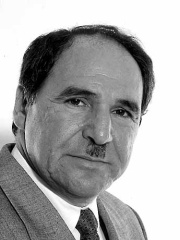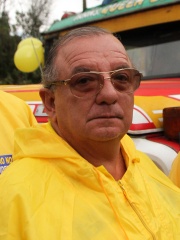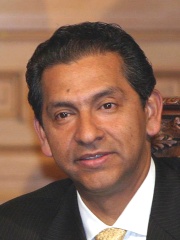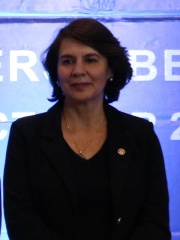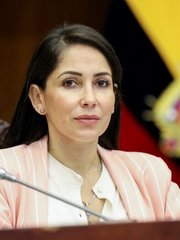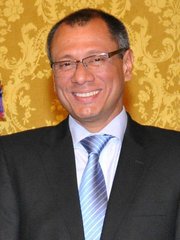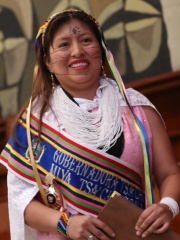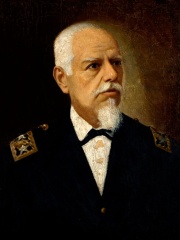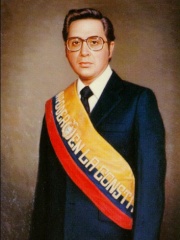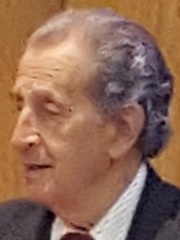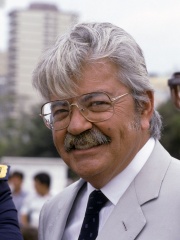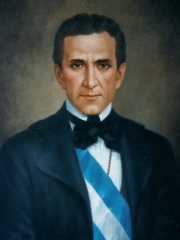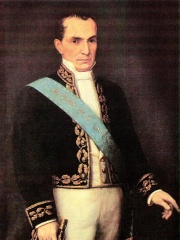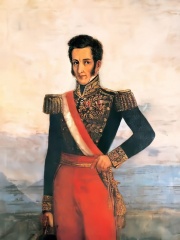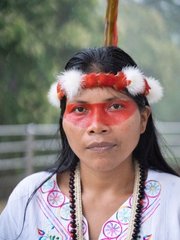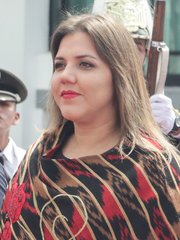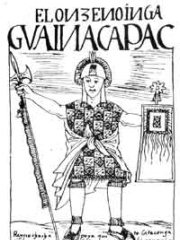
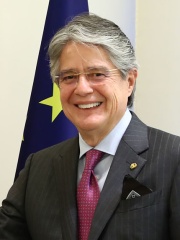
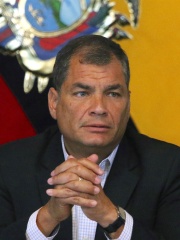
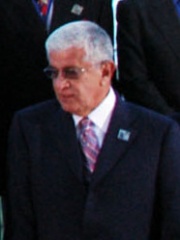
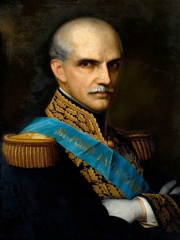
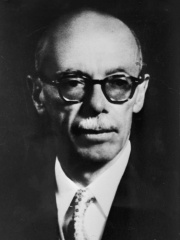
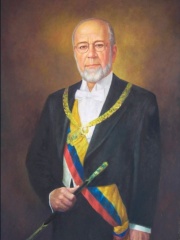
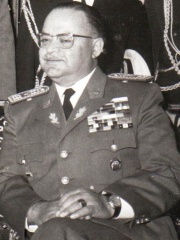
The Most Famous
POLITICIANS from Ecuador
This page contains a list of the greatest Ecuadorean Politicians. The pantheon dataset contains 19,576 Politicians, 43 of which were born in Ecuador. This makes Ecuador the birth place of the 75th most number of Politicians behind Mongolia, and Iceland.
Top 10
The following people are considered by Pantheon to be the top 10 most legendary Ecuadorean Politicians of all time. This list of famous Ecuadorean Politicians is sorted by HPI (Historical Popularity Index), a metric that aggregates information on a biography's online popularity. Visit the rankings page to view the entire list of Ecuadorean Politicians.

1. Huayna Capac (1476 - 1525)
With an HPI of 70.82, Huayna Capac is the most famous Ecuadorean Politician. His biography has been translated into 36 different languages on wikipedia.
Huayna Capac ( WY-nə KAP-ak; Cusco Quechua: Wayna Qhapaq [ˈwajna ˈqʰapaχ] – lit. 'the young generous one'; Spanish: [ˈwajna ˈkapak]; before 1493 – 1527) was the eleventh Sapa Inca of Tawantinsuyu, the Inca Empire. He was the son of and successor to Túpac Inca Yupanqui, the sixth Sapa Inca of the Hanan dynasty, and eleventh of the Inca civilization. He was born in Tumipampa and tutored to become Sapa Inca from a young age. Tawantinsuyu reached its greatest extent under Huayna Capac, as he expanded the empire's borders south along the Chilean coast, and north through what is now Ecuador and southern Colombia. According to the priest Juan de Velasco he absorbed the Quito Confederation into his empire by marrying Queen Paccha Duchicela, halting a long protracted war. Huayna Capac founded the city Atuntaqui and developed the city Cochabamba as an agriculture and administrative center. The Sapa Inca greatly expanded the Inca road system and had many qullqa (storehouses) built. Huayna Capac died in 1527, possibly from a European disease introduced to the Americas by the Spaniards. The death of him and his eldest son Ninan Cuyochi sparked the Inca Civil War, in which his sons Huáscar and Atahualpa fought over succession as the next Sapa Inca. Tawantinsuyu fell to Spanish conquests shortly after Atahualpa's victory.

2. Guillermo Lasso (b. 1955)
With an HPI of 70.47, Guillermo Lasso is the 2nd most famous Ecuadorean Politician. His biography has been translated into 157 different languages.
Guillermo Alberto Santiago Lasso Mendoza (Latin American Spanish: [ɡiˈʝeɾmo ˈlaso]; born 16 November 1955) is an Ecuadorian businessman, banker and politician who served as the 47th president of Ecuador from 2021 to 2023. Lasso served as Superminister of Economy during the Jamil Mahuad presidency briefly in 1999. He previously served as Governor of Guayas from 1998 to 1999. In 2003, he briefly served as the Itinerant Ambassador of Ecuador during the Lucio Gutiérrez administration. Aside from his political career, Lasso is also a banker and previously was CEO of Banco Guayaquil. During the presidency of Rafael Correa, Lasso became a noted critic of his administration. A traditional economic liberal, his public agenda includes classical liberal points such as the defence of the division of powers to limit government and of fundamental rights. He has also expressed opinions in favour of lower taxes and is a free-market advocate. Lasso became involved in presidential politics when he founded the Creating Opportunities Party in 2012. He first ran for president in 2013 where he came in a distant second place behind President Correa. He would later run again in the 2017 election, advancing to the run-off, running against former vice president Lenín Moreno, and narrowly losing the election. In his third presidential campaign in 2021, Lasso narrowly advanced to the April run-off round of the election in February and was later elected. Lasso's presidency was noted for COVID-19 vaccination initiatives and economic relief packages through tax increases on the wealthy and funding with the International Monetary Fund. However, the increase of food and fuel prices, as well as his economic policies, culminated in a series of protests across the country. The government's response raised concerns over human rights abuses, with crackdowns on indigenous protests at the hands of security forces, as well as alleged excessive force against journalists. Lasso's approval rating dropped significantly throughout 2022 and in 2023. In May 2023, the National Assembly officially began a second impeachment proceeding against Lasso. On 17 May, Lasso dissolved the National Assembly by invoking a constitutional measure known as muerte cruzada, triggering the 2023 general election, in which he did not run and was succeeded by Daniel Noboa.

3. Rafael Correa (b. 1963)
With an HPI of 68.78, Rafael Correa is the 3rd most famous Ecuadorean Politician. His biography has been translated into 158 different languages.
Rafael Vicente Correa Delgado (Spanish pronunciation: [rafaˈel βiˈsente koˈre.a ðelˈɣaðo]; born 6 April 1963) is an Ecuadorian politician and economist who served as the 45th president of Ecuador from 2007 to 2017. The leader of the PAIS Alliance political movement from its foundation until 2017, Correa is a democratic socialist and his administration focused on the implementation of left-wing policies. Internationally, he served as president pro tempore of the UNASUR. Since 2017, he has been living with his family in Belgium. Born to a lower middle-class mestizo family in Guayaquil, Correa studied economics at the Universidad Católica de Santiago de Guayaquil, the University of Louvain (UCLouvain), and the University of Illinois, where he received his PhD. Returning to Ecuador, in 2005 he became the Minister for the Economy under President Alfredo Palacio, successfully lobbying Congress for increased spending on health and education projects. Correa won the presidency in the 2006 general election on a platform criticizing the established political elites. Taking office in January 2007, he sought to move away from Ecuador's neoliberal economic model by reducing the influence of the World Bank and International Monetary Fund. He oversaw the introduction of a new constitution, being reelected in 2009 and again in the 2013 general election. Correa's presidency was part of the Latin American pink tide, a turn toward leftist governments in the region, allying himself with Hugo Chávez's Venezuela and bringing Ecuador into the Bolivarian Alliance for the Americas in June 2009. Using its own form of 21st century socialism, Correa's administration increased government spending, reducing poverty, raising the minimum wage and increasing Ecuador's standard of living. From 2006 to 2016, poverty decreased from 36.7% to 22.5% and annual per capita GDP growth was 1.5% (as compared to 0.6% over the previous two decades). At the same time, economic inequality, as measured by the Gini coefficient, decreased from 0.55 to 0.47. By the end of Correa's tenure, the 50% drop in the price of oil since 2014 had caused Ecuador's economy to enter a recession, resulting in government spending being slashed. On 3 July 2018, a judge in Ecuador ordered a warrant for Correa's arrest after he failed to appear in court during a trial surrounding the kidnapping of his political opponent Fernando Balda. Correa, who lived in Belgium at the time, denied the allegations regarding the kidnapping. In July 2018 Interpol rejected an Ecuador-issued arrest warrant and called it "obviously a political matter." In April 2020 the Criminal Court of the National Court of Justice found Correa guilty of aggravated passive bribery in the caso Sobornos 2012-2016. He was sentenced in absentia to 8 years in prison.

4. Alfredo Palacio (1939 - 2025)
With an HPI of 67.99, Alfredo Palacio is the 4th most famous Ecuadorean Politician. His biography has been translated into 40 different languages.
Luis Alfredo Palacio González (22 January 1939 – 22 May 2025) was an Ecuadorian cardiologist and politician who was the 44th president of Ecuador from 2005 to 2007. He had been the 44th vice president under President Lucio Gutiérrez, until he was appointed to the presidency when the Ecuadorian Congress removed Gutiérrez from power following a week of growing unrest with his government. He previously served as Minister of Health between 1994 and 1996.
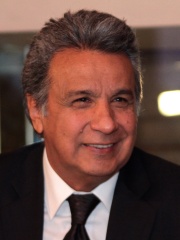
5. Lenín Moreno (b. 1953)
With an HPI of 65.48, Lenín Moreno is the 5th most famous Ecuadorean Politician. His biography has been translated into 61 different languages.
Lenín Voltaire Moreno Garcés (Spanish: [leˈnim bolˈtajɾe moˈɾeno ɣaɾˈses]; born 19 March 1953) is an Ecuadorian politician who served as the 46th president of Ecuador from 2017 to 2021. He was also vice president from 2007 to 2013, serving under President Rafael Correa. He was nominated as the candidate for Correa's PAIS Alliance, a social democratic political party, in the 2017 presidential election and won a narrow victory in Ecuador's second round of voting on 2 April 2017. However, after his election Moreno drastically shifted his political stance, distancing himself from Correa's leftist legacy in both domestic and foreign policy. By the end of Moreno's presidency he had left office with a staggeringly low approval rating of 9%, the lowest in modern Ecuadorian history. He was expelled from PAIS Alliance in March 2021 after the party's crushing defeat in the 2021 elections. Moreno was shot in a 1998 robbery attempt and thereafter has used a wheelchair. For his advocacy for people with disabilities, he was nominated for the 2012 Nobel Peace Prize. According to The New York Times, while he was in office from 2017 to 2021, Moreno was the world's only serving head of state to use a wheelchair.

6. Gabriel García Moreno (1821 - 1875)
With an HPI of 62.49, Gabriel García Moreno is the 6th most famous Ecuadorean Politician. His biography has been translated into 24 different languages.
Gabriel Gregorio Fernando José María García Moreno y Morán de Butrón (24 December 1821 – 6 August 1875), was an Ecuadorian politician and aristocrat who twice served as President of Ecuador (1861–65 and 1869–75) and was assassinated during his second term after being elected to a third. He has been described as a dictator and caudillo. García Moreno was a conservative and centralist who supported state building and strong executive power. He was involved in the Battle of Cuaspud (6 December 1863) alongside General Juan José Flores, where an unexpected Ecuadoran defeat ended their project of military and political consolidation, drastically reducing Ecuador’s army and weakening their centralization efforts. He is noted for his conservatism, nationalism, Catholic religious perspective and rivalry with liberal strongman Eloy Alfaro.

7. José María Velasco Ibarra (1893 - 1979)
With an HPI of 61.27, José María Velasco Ibarra is the 7th most famous Ecuadorean Politician. His biography has been translated into 30 different languages.
José María Velasco Ibarra (19 March 1893 – 30 March 1979) was an Ecuadorian politician. He became president of Ecuador five times, in 1934–1935, 1944–1947, 1952–1956, 1960–1961, and 1968–1972. Only in 1952–1956 did he complete a full term. In his four other terms, he was removed by military force, and several times he was installed as president through a military coup.

8. Gustavo Noboa (1937 - 2021)
With an HPI of 61.14, Gustavo Noboa is the 8th most famous Ecuadorean Politician. His biography has been translated into 31 different languages.
Gustavo José Joaquín Noboa Bejarano (21 August 1937 – 16 February 2021) was an Ecuadorian politician who served as the 42nd president of Ecuador from 22 January 2000 to 15 January 2003. Previously he served as the 42nd vice president under President Jamil Mahuad from 1998 until 2000. From 1983 until 1984, he also was the Governor of the province of Guayas. Born in Guayaquil, Noboa's political career began when he was appointed Governor of the Guayas Province by President Osvaldo Hurtado in 1983 where left the role the following year. In 1998, Noboa was the running mate of Jamil Mahuad, where their ticket won and Noboa became vice president. On 21 January 2000, after growing discontent with the people of Ecuador, especially the Indigenous people of his handling of the severe economic crisis, Mahuad was ousted in a coup d'état led by Colonel Lucio Gutiérrez. Noboa eventually became president and was officially sworn in the following day. His government attempted to revive the country's economy. Noboa left office in January 2003 and was succeeded by Lucio Gutiérrez, the leader of the coup that deposed Mahuad. Shortly after leaving office, Noboa was convicted of charges and fled the country where he was given asylum in the Dominican Republic. However, he was subsequently placed under house arrest in 2005, but was later lifted the following year.

9. Guillermo Rodríguez (b. 1924)
With an HPI of 60.80, Guillermo Rodríguez is the 9th most famous Ecuadorean Politician. His biography has been translated into 21 different languages.
Guillermo Antonio Rodríguez Lara (born 4 November 1923) is an Ecuadorian former political and military leader who was the dictator of Ecuador from 1972 to 1976. He came to power after leading the 1972 military coup against President José María Velasco Ibarra. He characterised his government as "revolutionary and nationalistic."
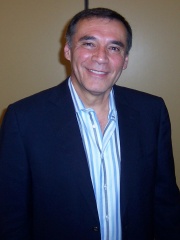
10. Jamil Mahuad (b. 1949)
With an HPI of 60.52, Jamil Mahuad is the 10th most famous Ecuadorean Politician. His biography has been translated into 28 different languages.
Jorge Jamil Mahuad Witt (born 29 July 1949) is an Ecuadorian lawyer, academic and former politician who served the 41st president of Ecuador from 1998 until he was deposed in a coup in 2000. He previously served as the 17th mayor of Quito from 1992 to 1998. Born in Loja of German and Lebanese descent, Mahuad grew up studying law. He studied in the Pontificia Universidad Católica del Ecuador and earned a law degree from Harvard University. In 1988, Mahuad entered politics and ran unsuccessfully for the presidency in the elections held that year. He then became the Metropolitan Mayor of Quito in 1992. In 1998, Mahuad ran again for the presidency in the elections and narrowly won against Álvaro Noboa, the richest man in the country at the time. However, Noboa refused to concede and demanded a recount, which was denied by the authorities responsible. Mahuad signed a historic agreement with Peru during his presidency, which solved long-standing border disputed between the two. At the same time however, there was a severe economic crisis in the country due to the Asian financial crisis the previous year. Mahuad decided to dollarize the country's economy which caused outrage across the country and eroded public support. The indigenous Ecudorians protested against Mahuad and he was eventually deposed in a coup d'état led by Lucio Gutiérrez and Mahuad's vice president, Gustavo Noboa, became president according to constitutional order.
People
Pantheon has 43 people classified as Ecuadorean politicians born between 1476 and 1998. Of these 43, 15 (34.88%) of them are still alive today. The most famous living Ecuadorean politicians include Guillermo Lasso, Rafael Correa, and Lenín Moreno. The most famous deceased Ecuadorean politicians include Huayna Capac, Alfredo Palacio, and Gabriel García Moreno. As of April 2024, 4 new Ecuadorean politicians have been added to Pantheon including Luisa González, Jorge Glas, and Nemonte Nenquimo.
Living Ecuadorean Politicians
Go to all RankingsGuillermo Lasso
1955 - Present
HPI: 70.47
Rafael Correa
1963 - Present
HPI: 68.78
Lenín Moreno
1953 - Present
HPI: 65.48
Guillermo Rodríguez
1924 - Present
HPI: 60.80
Jamil Mahuad
1949 - Present
HPI: 60.52
Abdalá Bucaram
1952 - Present
HPI: 58.43
Álvaro Noboa
1950 - Present
HPI: 58.24
Lucio Gutiérrez
1957 - Present
HPI: 54.99
Rosalía Arteaga
1956 - Present
HPI: 54.93
Luisa González
1977 - Present
HPI: 48.79
Jorge Glas
1969 - Present
HPI: 45.33
Diana Aguavil
1983 - Present
HPI: 45.00
Deceased Ecuadorean Politicians
Go to all RankingsHuayna Capac
1476 - 1525
HPI: 70.82
Alfredo Palacio
1939 - 2025
HPI: 67.99
Gabriel García Moreno
1821 - 1875
HPI: 62.49
José María Velasco Ibarra
1893 - 1979
HPI: 61.27
Gustavo Noboa
1937 - 2021
HPI: 61.14
Eloy Alfaro
1842 - 1912
HPI: 60.32
Jaime Roldós Aguilera
1940 - 1981
HPI: 60.19
Rodrigo Borja Cevallos
1935 - 2025
HPI: 60.18
León Febres Cordero
1931 - 2008
HPI: 59.60
José Joaquín de Olmedo
1780 - 1847
HPI: 58.16
Vicente Rocafuerte
1783 - 1847
HPI: 56.80
José de la Mar
1778 - 1830
HPI: 56.76
Newly Added Ecuadorean Politicians (2025)
Go to all RankingsLuisa González
1977 - Present
HPI: 48.79
Jorge Glas
1969 - Present
HPI: 45.33
Nemonte Nenquimo
HPI: 38.77
María Alejandra Vicuña
1978 - Present
HPI: 37.82
Overlapping Lives
Which Politicians were alive at the same time? This visualization shows the lifespans of the 25 most globally memorable Politicians since 1700.

